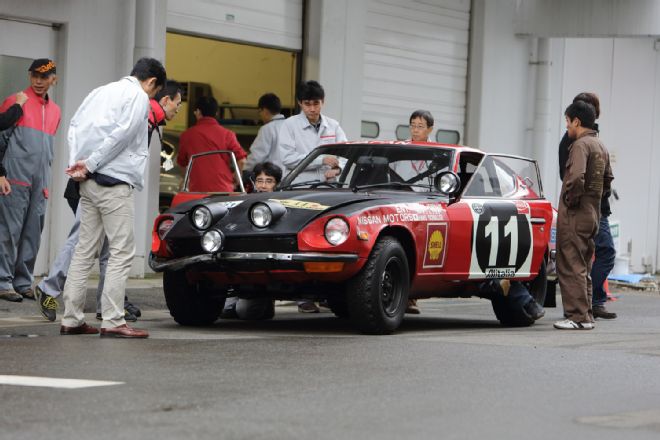Safari Rally Z Restoration Details:
Nissan Restoration Club is a group of specialist volunteers from Nissan’s Technical Center
Eighth car restored by club since 2006
Car won 1971 East African Safari Rally
Proved Z platform’s merits in motorsport besides road racing
This month the Nissan Restoration Club (NRC) – a group of volunteers from the company’s Japanese R&D facility endeavoring to get Nissan’s historic race cars rolling again – wrapped up its latest project, reanimating a renowned Safari Rally Z. The special variant of the Fairlady Z (referred to as Datsun 240Z in the Usa) won two overall East African Safari Rally titles, in 1971 and again in ’73, and more critically made a term for the circuit-working fastback coupe as a fishtailing dirt fighter.
The team decided to resuscitate the winning racer of the ’71 event, driven then by Edgar Hermann and Hans Schuller, which contains since been sitting on display in Nissan’s Heritage Collection at the Zama Operations Center in Kanagawa. In the past the club has brought to life the legendary 1964 Skyline race car, the Fuji and Sakura Datsun 210s that won Australia’s 1958 Mobilgas Trial and the 1947 Tama electric vehicle.
We recently had the pleasure of exchanging emails with NRC member Yukitaka Arakawa, who clued us in the club and what it takes to bring backWhen and why was the club started?
Yukitaka Arakawa: The Nissan Great Car Restoration Club was started in 2006 as a performance improvement activity, mainly to examine the highest technology Nissan had to offer at that time. The purpose of Restoration Club activities is two-fold.
Firstly, the club returns Nissan’s heritage vehicles to running condition when the vehicle was active. For the Safari Rally Z we wanted to take it straight back to its finished condition following the 1971 East African Safari Rally; for the car just like the 240RS Group B rally racer [from the mid-1980s], simply because it was just a demonstration car and had no actual rally participation history, we took the car to the condition it was actually shipped in from the factory in Oppama.
Sometimes the cars within the Zama Heritage Garage are not in original condition; the Safari Rally Z, by way of example, was displayed with a single carburetor and rubber upper radiator hose, while in racing spec actually used Weber triple carbs and a steel upper hose. We bring cars returning to their original used condition.
Secondly, we study senior engineer’s intentions, technical ideas and Mono-zukuri (manufacturing) from theWhat was the first car restored? What has been the most lengthy restoration and why?
YA: Our first vehicle was the 240RS Group B rally car. It also depends on the vehicle’s condition, though generally, body sheeting and paint take too much time. For the Fuji and Sakura 210s, which we restored in the year 2011, reproducing the images of cherry blossoms and Mt. Fuji about the hood and trunk of these cars was one of the more difficult operations. We traced original pictures onto paper, and then copied them to the bodies, an artisan performing everything by hand.
The Tama EV restored in 2010 also took a long time for body sheeting due to its wooden frame with steel panel structure. Gathering original vehicle condition information and parts also adds to the time it takes to restore a car.
IT: What percentage of the 60 current members are Nissan employees?
YA: All of our members are Nissan employees or with sister companies. We work mainly on Saturdays.
Nissan restoration club safari rally z members tinkering under hood.JPG
Nissan restoration club safari rally z l24 inline 6.JPG
Nissan restoration club safari rally z members examine undercarriage.JPG
IT: How does Nissan corporate support the club?
YA: Nissan permits use of its facilities and workshops at the Nissan Technical Center in Kanagawa, the company’s R&D base. It houses specialists in braking, engines, chassis, styling, body and electrical and power trains, along with the club’s home workshop.
IT: Sounds like there is lots of planning involved in restoration of the cars. Can you take us through how much of challenging they have been? For instance, do you have to fabricate new parts? How is each car re-engineered?
YA: Each specialized division makes related parts. For example, engine parts are created or ordered through the engine development division. Bodies are restored within the pre-production division.
IT: The time/man hours has it been taking to complete them?
YA: Generally, it will require 2,400 hours, but it also depends on vehicle condition. The Tama EV took the greatest amount of time.
Nissan restoration club safari rally z members prepare to shakedown.JPG
Nissan restoration club safari rally z members redo livery.JPG
Nissan restoration club safari rally z headlights.JPG
IT: After completion, the frequency of which do restorations become regular drivers or see the track?
YA: We confirm restored vehicles running condition almost every other year at the Oppama proving grounds. Our members are each division’s test driver.
IT: Which restoration continues to be the most fun to drive?
YA: Each member likes different restorations for various reasons. I enjoy the Group B 240RS and Sunny 1400 Excellent (from the 1970s, restored in 2008). Generally, we love motorsports vehicles best.
IT: What do you plan to do with it when it’s complete?
YA: We ran the vehicle at the 2013 Nismo Festival at Fuji Speedway. We hope beside run the vehicle at the 2014 Goodwood Festival of Speed in the U.K. if it’s possible.
*Photography by Nissan Restoration Club
For GREAT deals on a new or used Harley check out Orange County Harley Davidson TODAY!
